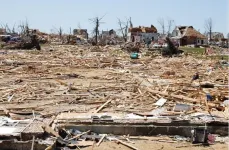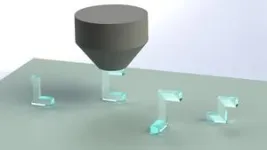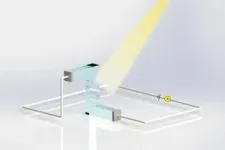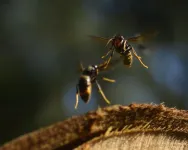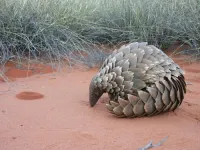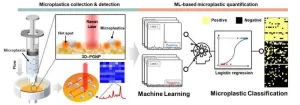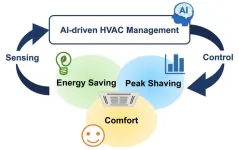(Press-News.org) AMES, Iowa – The foundation of a house remains, the basement ripped open and exposed, with the rest of the house blown away. A brick-veneered bank building partially caved in. A collapsed high school gym. Gravestones knocked over. Debris piercing a building.
Partha Sarkar kept hitting next, scrolling through the photo evidence of the destruction he gathered and assessed the day after an EF5 tornado ripped through Parkersburg on May 25, 2008.
Then Sarkar, professor and interim chair of aerospace engineering at Iowa State University, opened a photo showing a house located on the edge of the tornado’s path. It was damaged, but still standing, shingles gone, but the roof structure mostly intact. Sarkar’s engineering studies, based on small-scale models of structures tested in wind tunnels, are designed to produce more of that – structures that stand up to extreme windstorms, protecting lives and property.
Now those studies, spanning his entire academic career, are getting a major upgrade – and the potential for acquiring a better and more powerful wind simulator.
Sarkar and a research team he’s leading have just won a four-year, $14 million grant from the U.S. National Science Foundation (NSF) to design and plan a National Testing Facility for Enhancing Wind Resiliency of Infrastructure in Tornado-Downburst-Gust Front Events, or NEWRITE.
If it’s built, the facility would allow testing at large-scales (a full-scale house or 1:10 scale models of buildings with large footprints such as retail buildings, shopping malls or hospitals) and high wind speeds (86-225 mph for EF1 to EF5 tornadoes, 100-125 mph for downbursts, 80-100 mph for gust fronts) in simulated windstorms.
“Being able to test structures at much larger scales, in extreme winds produced in these windstorms, will bring us closer to understanding reality and help engineers to improve the wind resilience of structures,” Sarkar said.
The grant will also support replacing Iowa State’s Tornado/Microburst Simulator that was completed in 2005. The existing simulator, housed in Howe Hall, is capable of 80 mph winds and a tornado-like vortex that’s 3.7 feet in diameter. The new simulator will be about a 1/20th-scale model of the full-scale NEWRITE and about the same size as the existing facility (18 feet in diameter) but will have the capacity to generate 225 mph tornado-like winds.
Researchers will also model and produce a “digital twin” of the full-scale and 1/20th-scale NEWRITE simulators to help them design the proposed facility.
Sarkar said the project is all about simulating tornadoes and other types of localized, non-synoptic windstorms, measuring the wind loads they exert on homes and other structures and engineering improvements that reduce structural damage.
“NEWRITE will be designed to be a state-of-the-art research and testing platform to mitigate the impacts of (localized windstorm) hazards on the built environment and significantly reduce fatalities and economic losses,” the researchers wrote.
Sarkar will lead the project team. Other project co-leaders are Alice Alipour, an associate professor of civil, construction and environmental engineering at Iowa State; Anupam Sharma, an associate professor of aerospace engineering at Iowa State; Guirong (Grace) Yan, an associate professor of structural engineering at Missouri University of Science and Technology in Rolla; and Delong Zuo, a professor of civil, environmental and construction engineering at Texas Tech University in Lubbock.
Other senior researchers (see sidebar) are from Iowa State, Clemson University in South Carolina; Northeastern University in Boston; the University of Arkansas in Fayetteville; the University of Florida in Gainesville; the University of Washington in Seattle; and the University of Wisconsin in Madison.
This design grant does not commit the NSF to supporting construction of the full-scale NEWRITE facility. If there is future support, Sarkar said it is likely to be built at Iowa State. He estimates the national testing facility would require a five-story building that could cover the square footage of four football fields. The facility would also require 5 to 10 megawatts of electricity.
In addition to NEWRITE, the NSF also awarded grants to three other research infrastructure projects: design of a laser laboratory at the University of Rochester in New York; an ocean observatory for earthquake activity at the University of Washington; and a cybersecurity institute at the University of Southern California in Los Angeles.
The four projects “exemplify the most novel, innovative infrastructure being designed and built in our country to advance the best ideas and train the highly skilled talent in science and engineering for our future,” said Sethuraman Panchanathan, director of the NSF. “By investing in the most innovative infrastructure, NSF aims to strengthen opportunities for all Americans and advance the frontiers of science and technology.”
– 30 –
The NEWRITE Team
In addition to Iowa State’s Partha Sarkar, the leader of the proposed national testing facility, the project team includes:
Iowa State University – Alice Alipour, Bill Gallus, Paul Kremer, Anupam Sharma and Sri Sritharan
Clemson University – Nigel Kaye
Missouri University of Science and Technology – Guirong (Grace) Yan
Northeastern University – Luca Caracoglia
Texas Tech University – Delong Zuo
University of Arkansas – R. Panneer Selvam
University of Florida – David Prevatt
University of Washington – Dorothy Reed
University of Wisconsin – Leigh Orf
END
Researchers design a national testing facility to simulate tornadoes, downbursts and gusts; Experiments will help them engineer buildings that can stand up to extreme winds
2023-10-05
ELSE PRESS RELEASES FROM THIS DATE:
Shining a light on tiny, solar-powered animals
2023-10-05
Acoels have been found to host a wide diversity of symbiotic, photosynthetic microalgae.
Animals and plants need energy. Some animals get energy by eating other animals, and many plants harvest the energy in sunlight through photosynthesis. However, in the ocean, there exists a remarkable group of small, worm-like animals called acoels that do both—some acoels form relationships (symbiosis) with single-celled, photosynthetic microalgae.
A study by Assistant Professor Kevin Wakeman and his undergraduate student, Siratee Riewluang, at Hokkaido University, Japan, has shed some light on the biodiversity underpinning symbiotic relationships between acoels and microalgae. ...
Bumblebees drop to shake off Asian hornets
2023-10-05
Bumblebees have a remarkably successful method for fighting off Asian hornets, new research shows.
When attacked, buff-tailed bumblebees drop to the ground – taking the hornets down with them. This either causes the hornet to lose its grip, or the bee raises its sting and tussles until the hornet gives up.
University of Exeter scientists witnessed over 120 such attacks, and were stunned to find that bumblebees fought off the hornets every time.
Despite this, they found bumblebee colonies had reduced growth rates in ...
AAAS launches STPF Rapid Response Cohort in AI to support policy development in Congress
2023-10-05
The American Association for the Advancement of Science (AAAS) has conceived of and launched a new artificial intelligence (AI) fellowship in just two months — record speed — to support leaders in Congress as they craft legislation, in particular policies related to emerging opportunities and challenges with AI. Capitol Hill’s surging interest in AI policy follows the public release of ChatGPT and other generative AI tools.
The STPF Rapid Response Cohort in AI operates under the AAAS Science & Technology Policy Fellowships (STPF) program and is part of the 51st class of 276 scientists and engineers placed across ...
New research into pangolin genomics may aid in conservation efforts
2023-10-05
A new paper in Molecular Biology and Evolution, published by Oxford University Press, for the first time provides a comprehensive set of genomic resources for pangolins, sometimes known as scaly anteaters, that researchers believe will be integral for protecting these threatened mammals.
Pangolins, which are found in Asia and sub-Saharan Africa, are the only mammals covered in scales. They are trafficked at record numbers for their meat and supposed medicinal properties. The animals are also at risk due to widespread deforestation of their native habitats. Pangolins are made up of eight surviving species ...
Can masculine marketing convince more men to eat vegan?
2023-10-05
Eating more plant-based meals is better for our health and better for the planet. But cultural preferences are significant barriers to reducing meat consumption - especially for men, who are underrepresented among vegans and vegetarians. Studies have found that eating meat is associated with masculinity, and that gender stereotypes label plant-based diets as suitable for women but not men. So is it possible to change the perception of plant-based food with marketing, and convince men to eat more of it?
“Men might be less inclined to consume vegan food due to the need to perform gender,” said Alma Scholz, lead author of a new study published in Frontiers in Communication. ...
Detecting microplastics(MPs) with light!!
2023-10-05
A research team led by Dr. Ho Sang Jung of the Department of Nano-Bio Convergence at the Korea Institute of Materials Science (KIMS), a government-funded research institute under the Ministry of Science and ICT, in collaboration with the KOTITI Testing & Research Institute, has developed the world's first technology to rapidly and highly sensitively detect microplastics(MPs) in the field, which are well known to cause human and genetic toxicity through environmental pollution and the food chain.
The on-site applicable MPs detection technology developed ...
Comfort with a smaller carbon footprint
2023-10-05
Osaka, Japan – As organizations work to reduce their energy consumption and associated carbon emissions, one area that remains to be optimized is indoor heating and cooling. In fact, HVAC – which stands for Heating, Ventilation, and Air Conditioning – represents, on average, about 40% of a building’s total energy use. Methods that conserve electricity while still providing a comfortable indoor environment for workers could make a significant difference in the fight against climate change.
Now, researchers from Osaka University have demonstrated significant energy savings through the application of a new, AI-driven algorithm ...
Study shows enhanced pandemic-related infection prevention and control practices reduced incidence of healthcare-associated infections
2023-10-05
A new study conducted by researchers at The University of Texas MD Anderson Cancer Center suggests that enhanced infection prevention and control (IPC) measures implemented to address the COVID-19 pandemic contributed to a significant decrease in many healthcare-associated infections (HAIs) and a reduction in respiratory viral infections (RVIs). The findings, published today in the American Journal of Infection Control (AJIC), provide some of the first evidence that strict pandemic-related IPC interventions reduced HAI rates among vulnerable patient populations.
“Previous, large-scale ...
New study reveals Australian Long COVID response lagging
2023-10-05
New research by RMIT University and Northern Health has examined Australia’s Long COVID services, guidelines and public health information, compared with international standards.
The researchers found Australia lacking in several categories, including early investigation, accessibility and availability of trustworthy public health information, and adequate multidisciplinary Long COVID services to meet demand.
Dean of RMIT’s School of Health and Biomedical Sciences and co-author on the paper, Professor Catherine Itsiopoulos, warned that this problem will only worsen over time.
“Long ...
Vaccine via the nasal passage could be the new line of defence against Strep A
2023-10-05
As Streptococcus A cases continue to be prevalent in Queensland and internationally, a new nasal vaccine could provide long-term protection from the deadly bacteria.
Associate Professor Manisha Pandey, Professor Michael Good, and their team from Griffith University’s Institute for Glycomics, are leading the development of a Strep A vaccine which is currently in Phase 1 clinical trials in Canada and quickly advancing to Phase 2 efficacy trials.
The team’s new preclinical research, recently published in Nature Communications, shows an experimental liposome-based vaccine approach incorporating a conserved M-protein epitope from Strep A and an immunostimulatory glycolipid (3D(6-acyl) ...
